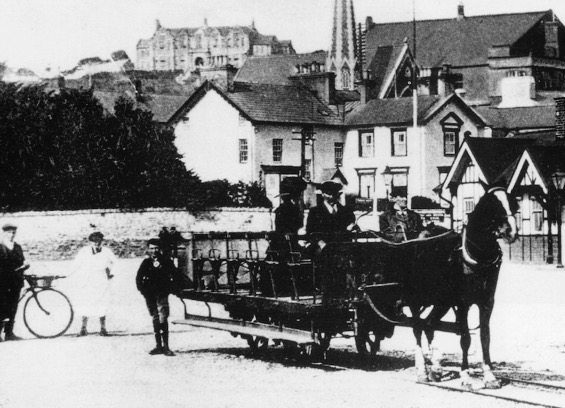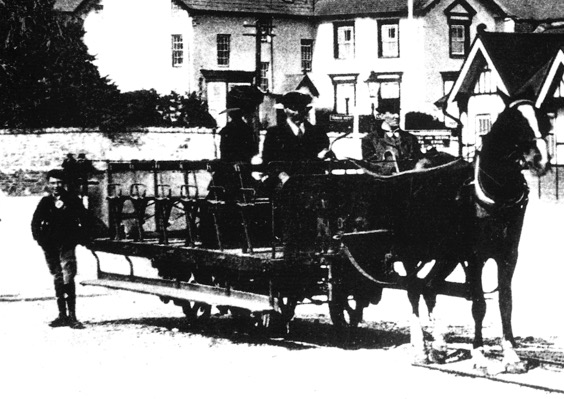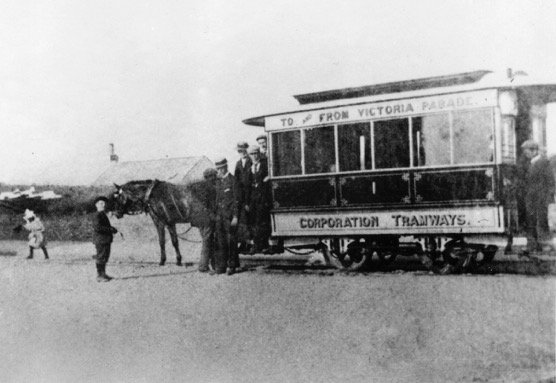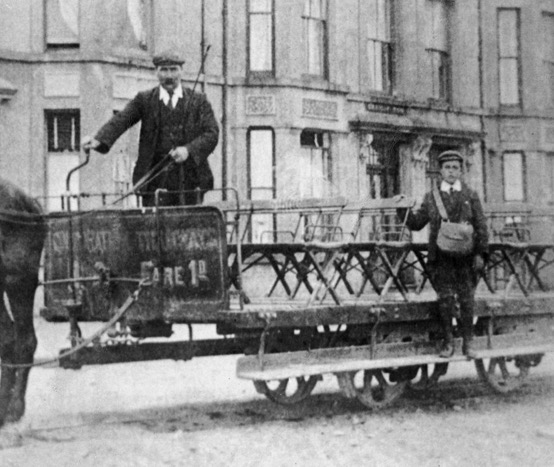Pwllheli Corporation Tramways
History
This short (0.51 miles), horse-drawn, corporation-owned tramway opened for business on the 24th July 1899. It was built to the unusually narrow gauge of 2ft 6ins, despite the fact that another horse-drawn concern — the Pwllheli and Llanbedrog Tramway —already operated within the town, but on a gauge of 3ft 0ins. The line ran southwards from the railway station along Embankment Rd to the terminus at Victoria Parade, and was never connected to the Pwllheli and Llanbedrog Tramway, which was owned by Cardiff-based, Solomon Andrews and Son.
The council seemed to have been spurred into action by the success of the company tramway, and though it proposed to build a number of lines, only one was ever built, and even this appears to have been of questionable legality, as it was built along a public road with neither the powers to do so nor Board of Trade approval to operate it.
The line was always going to be challenging to work profitably, especially when it was only open for a few short weeks during the summer tourist season. Unfortunately, throughout its life it was also plagued by the inability or unwillingness of the council to fund it properly, the latter frequently awarding contracts to the lowest bidder (by far), and suffering the inevitable consequences. This seems to have been a lesson that the council never learned, the tramway becoming ever more run down over the years due to lack of maintenance and the poor quality of the work that was done.
Whilst the tramway seems to have been moderately successful in its first decade, by 1910 the council was looking to lease it to a private operator. The response to its advertisement was however somewhat disappointing (there were none), as was an approach to Solomon Andrews and Son, which was firmly declined, both outcomes no doubt reflecting the meagre pickings that were on offer. The council therefore had no choice but to struggle on operating the tramway for a few weeks each summer, whilst spending as little as it could possibly get away with.
By 1916, the tramway was in a truly decrepit state, but still the council found itself unable to fund track relaying, even with second-hand rails. The tracks were therefore patched up once again (thankfully the line was straight) and operation was finally leased (in 1917 and 1918) to a local contractor, a Mr J T Williams. Even though the tracks were condemned by the borough surveyor in early 1919, the council somehow managed to wring another season out of them, though it was to be their last, and the last of all for the tramway. After much deliberation over the cost of replacement tracks, the decision was finally taken (in early 1920) to abandon the tramway. The last horse service therefore probably ran at the end of the summer season in September 1919.
Uniforms
Unlike its close neighbour, the Pwllheli and Llanbedrog Tramway, photographs of the short, corporation-owned line are relatively scarce. However, from the few that have survived, it is possible to state with some certainty that staff wore informal but smart attire — trousers, jackets, waistcoats, shirts and ties. Headgear appears to have largely followed the fashion of the day, predominantly the flat cap. No badges or licences of any kind were worn, either on the jackets or the caps.
Given the extreme shortness of the line, it is highly unlikely that the corporation employed inspectors, and there is certainly no evidence (photographic or otherwise) to suggest that they did so.
It is unclear whether women were ever employed (this would have been during the Great War), though photographic evidence would suggest not.
Further reading
For a history of the system, see: 'Pwllheli and Llanbedrog Tramways' by J F Andrews; D Brown and Sons (1995).
Images
Horse tram drivers and conductors
One of the corporation's two open-sided horsecars waits in Station Square for customers bound for Victoria Parade — photo undated, but probably taken in the early Edwardian era. Photo courtesy of the Tramways and Light Railway Society, with thanks to David Voice.
A blow-up of the above photo showing the driver (seated nearest the camera) and the conductor, both of whom are wearing informal attire. The conductor, whose cash bag buckle can be seen reflecting the light, looks very youthful indeed. 
Passengers detrain from the corporation's sole enclosed horsecar at Victoria Parade — photo undated, but probably taken in the early Edwardian era. The boy conductor can be glimpsed on the rear platform, once again in informal but smart attire. Photo courtesy of the Tramways and Light Railway Society, with thanks to David Voice.
A view of an open horsecar (outside the Victoria Hotel in Embankment Rd), but given the rather decrepit condition, clearly taken towards the end of the tramway's life (it closed in September 1919). Both the driver and his extremely young conductor are wearing informal but reasonably smart attire; no badges or licences are in evidence. Photo courtesy of the Tramways and Light Railway Society, with thanks to David Voice.